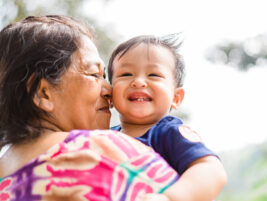The Congress is nearing its end.
We started off with the vibrant melodies and rhythm of traditional Irish music and dance. As Campbell said then – this is what makes us want to dance and move like we did as young children.
Kevin Nugent’s plenary address was then a beautiful transition from the preverbal to the verbal. The “one great buzzing confusion” became articulated by him as we were led into imagining the inner world of the baby.
The placing of the subjectivity of the infant at the centre of our enquiry is something that is at the core of IMH and at the core of Campbell’s way of working.
However, we also need to dissect, to break into parts different aspects of early development in order to gain a better understanding of early relationships – we need to tease out pathways, and have yellow triangles and blue rectangles so that we can grasp infinite mechanisms that constitute our brain activity. This is at one end of the spectrum.
However, there is also the other end – the whole, the imagination, the inner life – that is of equal importance. This is what indigenous practices can teach us and bring us back to. Cath Chamberlain has shown us through beautiful images what this means; the big round as opposed to the silos. In the holistic approach of the indigenous world views everything is connected and there is a constant interplay between various elements or forces. This is contrasted to the objective scientific methodology where we divide, separate, and split up the elements in order to examine each one separately. These opposites need to be held and grappled with and they need to ‘talk’ to each other.
But, as Dr Brenda Harden told us, committees, and governments like brain slides, and so the research is useful to show that early experiences REALLY do matter.
So, if we know all of this – also from a purely objective scientific perspective of the neurosciences – why is so little happening in the world that shows that the message of the importance of the early years has sunk in, and has been integrated into global consciousness?
I would like to focus on a few points that might throw some light on why society does not heed the call for action “It’s enough already”?
What is the resistance?
- Infants and young children are not lobby groups – they cannot talk, they cannot tell us directly of their needs and they do not vote….so, they have no power on a collective, political level.
- They also do not contribute to society financially – on the contrary, they draw on societies’ finances – but what we forget is that they are the future of society’s financial well-being. And that to invest in them now, costs a lot less than what a troubled adolescent or adult would cost society.
But, aside from these macro-systemic realities, there are other challenges.
- The fact that infants have sentience is daunting and that this sentience may impact brain development is even more daunting. It places an enormous responsibility on the adult world.
- How do infants get the help they need?
While discussion and acknowledgement of mental health, in general, is becoming less stigmatized, infant mental health remains a rather nebulous concept.
Infants show their distress in non-verbal, somatic ways – through crying, not sleeping, not eating, not thriving….
If parents are not aware that these signs may be symptoms of distress, it is up to the paediatrician, the community health worker, and the nurse, to pick this up.
- Setting up specialized IMH Services is expensive. Keeping the baby in mind is difficult when there are so many other stressors in the environment.
What can be done?
However, there are also simple, less complex ways to focus on those early months and years.
In most countries, perinatal services exist, and infants are documented and are immunized. This could be the point of entry by asking simple questions about the mother’s mental health, her anxieties or not about the baby, and observing the infant’s interactions with the mother and others. These very small, but focused observations could mean a lot to the mother and could also be red flags for the health worker to perhaps follow this baby up a bit sooner….in that way build the relationship. So, it need not be specialized or expensive, awareness and simple actions can be built into ordinary, regular practice.
This means creating awareness of infants’ mental health in the wider professional community. That it becomes the terrain of multiple disciplines – dieticians, social workers, speech therapists, occupational therapists, community health workers etc.
It is these multiple disciplines that would benefit from upskilling – once one learns to observe the infant and understands the non-verbal gestures, the rest follows. It is an accessible field, it is a field where relationships are at the centre.
As human beings, this comes to us naturally. It’s what holds us together as a human group.
But the Eros that we have all felt during this congress, has been usurped by the power complex of some world leaders and has led to untold suffering and devastation – the suffering of the infants and young children being muffled by the sounds of warring factions and ongoing discrimination of indigenous peoples, as Cath Chamberlain described. Our world is also hurtling from one natural catastrophe to the next so our only secure base is being threatened.
What can we do? We can all play our part – doing what we can, bit by bit, we can support each other, we can talk to each other – like we have- and continue to do so with our virtual connections, and help each other by being with each other until the next Congress.
Authors
Astrid Berg,
WAIMH President Elect,
South Africa








